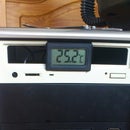Introduction: Reusing a GU10 Halogen Lamp Reflector
Tiny LEDs emit a lot of light, but the light is poorly directed. Making your own reflector doesn't give a neat result in most cases, so why not reuse a reflector?
I found out that GU10 halogen spots are easy to disassemble, and easy to reuse. This particular lamp was a cheap one I got included with a fixture and it broke after only a few hundred hours. Note that depending on how your own specimen was assembled, the disassembly might be harder.
Note on this video tutorial: this was a different bulb than in the pictures, and as you will see, the ceramic part broke off, which isn't as desired. Wriggling the pins more carefully should prevent this.
Step 1: Remove the Pins on the Back and the Front Glass
Using pliers it's quite easy to remove the pins. Make sure you have a firm grip and start rotating the pins until they come off the lamp's wires. If you feel that they have come off, you might need to pull them out using the pliers with a little force.
Now, of course you will need to get the halogen lamp out, which by now should be rattling in the housing. Here the fun part comes in. Using a small pointy hammer (or your pliers if you're also too lazy to get a hammer), hit the middle of the front glass. Start gently and increase your force carefully. I would recommend doing this over a bin to catch the glass shards.
In my case, I got lucky, the glass broke in a few large pieces. Since this was a cheap lamp, the front glass seemed to be glued to the reflector. Using pliers you should be able to remove any pieces still connected to the reflector. With a bit of luck it should come off quite clean. (for the picture I didn't do any sanding whatsoever)
Discard of the glass shards safely and keep them out of reach of small children!
Step 2: Connect Your Lighting of Choice
There is room for at least 2 LEDs in the back of the reflector. Make sure they stick in the reflector a bit to insure good light spread. The holes of the removed pins serve nicely as wire leads.
Step 3: Before/after Pictures
This is using one white LED from a discarded flashlight. It makes a huge difference as you can see.
Next step for me is to build an USB keyboard light similar to this: https://www.instructables.com/id/Powerfull-USB-Ligh...
Now I'd love to see how you reused a GU10 light.

Participated in the
First Time Author Challenge













